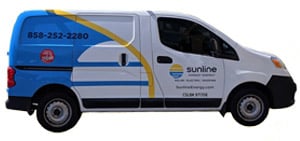Broadly speaking, there are 2 types of solar installations:
- Off-grid solar systems
- Grid-tied solar systems
This post describes the main differences between the 2, and it outlines which installation type is best suited for your needs.
Off-Grid Solar Systems – the Good and the Bad
Off-grid solar photovoltaic (PV) installations describe panels that aren’t connected to the utility network.
You usually see these systems on remote homes and buildings – i.e. structures that are too far from the utility grid.
The beauty of off-grid is that you can install the panels yourself. And with enough on-site battery storage, you can generate and keep all of the electricity you need.
In other words, you become 100% energy independent – even when the sun goes down or there’s a blackout across the utility grid.
The downside of off-grid solar installations is the cost.
- You have to buy battery storage. Although prices continue to come down, the upfront cost is prohibitively expensive for many home and business owners.
- You have to pay 100% out-of-pocket. Most off-grid solar installations don’t qualify for incentives. And none qualifies for net metering. This means that you’ll pay full price for your installation (whether you do it yourself or hire a licensed contractor).
Grid-Tied Solar Systems – the Good and the Bad
The vast majority of solar installations in San Diego are grid-tied systems. In other words, they’re connected directly to the utility network.
This approach has many advantages:
- Your system qualifies for tax credits, rebates, and other solar incentives (provided that it’s installed by a licensed contractor).
- Your system qualifies for San Diego’s net metering program. This means that you can sell excess electricity to the utility company at a profit.
- Your system pays for itself – usually within 4 to 6 years. With lower monthly electricity bills, you can use your savings to cover the upfront cost of your solar installation. And then you have free energy for the remaining 25 to 40 years of your system’s useful lifetime.
But there are some drawbacks to grid-tied solar installations:
- There’s more paperwork involved. At Sunline Energy, we handle these applications and forms for you, so you don’t have to worry.
- You’re not 100% protected from blackouts (unless you have on-site battery storage and a special inverter).
- You must hire a licensed contractor to finish the job. Utility companies do not allow amateur installations to be connected to the grid. But then again, professional installations are usually cheaper than do-it-yourself solar PV systems.
So Which Installation Type Is Best for You?
If you’re like most San Diego homeowners and businesses, your best bet is to go grid-tied.
Thanks to solar incentives and net metering, you can treat your installation as an investment – one that continues to pay financial and environmental dividends for decades.
Off-grid solar systems can help offset your carbon footprint – but you won’t be able to make money from your purchase. Off-grid solar installations are an expense – not an investment.
To learn more about the different types of solar PV systems – or to receive a free quote, contact us today. Sunline Energy is one of the top solar companies in San Diego. We have installed thousands of quality solar energy systems in Southern California.

